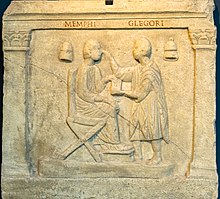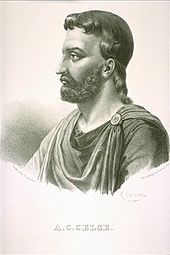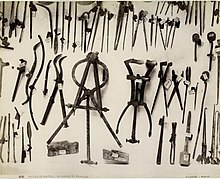This is a timeline of the history of medicine and medical technology.
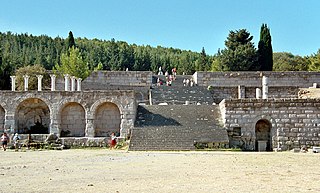
Asclepieia were healing temples in ancient Greece, dedicated to Asclepius, the first doctor-demigod in Greek mythology. Asclepius was said to have been such a skilled doctor that he could even raise people from the dead. So stemming from the myth of his great healing powers, pilgrims would flock to temples built in his honor in order to seek spiritual and physical healing.

Asclepiades, sometimes called Asclepiades of Bithynia or Asclepiades of Prusa, was a Greek physician born at Prusias-on-Sea in Bithynia in Anatolia and who flourished at Rome, where he practised and taught Greek medicine. He attempted to build a new theory of disease, based on the flow of "atoms" through pores in the body. His treatments sought to restore harmony through the use of diet, exercise, and bathing.

In the history of medicine, "Islamic medicine" is the science of medicine developed in the Middle East, and usually written in Arabic, the lingua franca of Islamic civilization.

Byzantine medicine encompasses the common medical practices of the Byzantine Empire from c. 400 AD to 1453 AD. Byzantine medicine was notable for building upon the knowledge base developed by its Greco-Roman predecessors. In preserving medical practices from antiquity, Byzantine medicine influenced Islamic medicine and fostered the Western rebirth of medicine during the Renaissance.
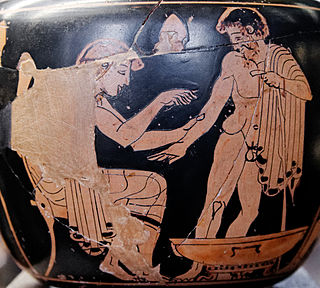
Ancient Greek medicine was a compilation of theories and practices that were constantly expanding through new ideologies and trials. The Greek term for medicine was iatrikē. Many components were considered in ancient Greek medicine, intertwining the spiritual with the physical. Specifically, the ancient Greeks believed health was affected by the humors, geographic location, social class, diet, trauma, beliefs, and mindset. Early on the ancient Greeks believed that illnesses were "divine punishments" and that healing was a "gift from the Gods". As trials continued wherein theories were tested against symptoms and results, the pure spiritual beliefs regarding "punishments" and "gifts" were replaced with a foundation based in the physical, i.e., cause and effect.

The Medical community as used in this article refers to medical institutions and services offered to populations under the jurisdiction of the late Roman Republic and the Roman Empire. The Medical services of the Roman Republic and the early Roman Empire were adopted from ancient Greece. It was first imported from Greece through Greek colonies in Magna Graecia and the Etruscan civilization. After the Roman conquest of Greece, enslaved Greeks brought more Greek medical knowledge to Rome. In 219 BCE a surgeon named Archagathus traveled from the Peloponnesus to Rome. He became a citizen and purchased a taberna near a crossroads. This became the first officina medica. Previously, the pater familias was responsible for the medical art in early Rome. Physicians in ancient Rome would take the Hippocratic Oath. Doctors would begin their appointments with patients by stating "si vales valeo," which translated to "if you are well I am well." Physicians were often wealthy. Augustus' physician, Antonius Musa, received a salary of 30,000 sesterces. Doctors would also serve in the Roman military and treat injured soldiers.
Asclepiad was a title borne by many Ancient Greek medical doctors, notably Hippocrates of Kos. It is not clear whether the Asclepiads were originally a biological family, or simply a member of an order or guild of doctors.

De Medicina is a 1st-century medical treatise by Aulus Cornelius Celsus, a Roman encyclopedist and possibly a practicing physician. It is the only surviving section of a much larger encyclopedia; only small parts still survive from sections on agriculture, military science, oratory, jurisprudence and philosophy. De Medicina draws upon knowledge from ancient Greek works, and is considered the best surviving treatise on Alexandrian medicine. It is also the first complete textbook on medicine to be printed, and has an "encyclopedic arrangement that follows the tripartite division of medicine at the time as established by Hippocrates and Asclepiades – diet, pharmacology, and surgery." This work also covers the topics of disease and therapy. Sections detail the removal of missile weapons, stopping bleeding, preventing inflammation, diagnosis of internal maladies, removal of kidney stones, the amputation of limbs and so forth.

Childbirth and obstetrics in classical antiquity were studied by the physicians of ancient Greece and Rome. Their ideas and practices during this time endured in Western medicine for centuries and many themes are seen in modern women's health. Classical gynecology and obstetrics were originally studied and taught mainly by midwives in the ancient world, but eventually scholarly physicians of both sexes became involved as well. Obstetrics is traditionally defined as the surgical specialty dealing with the care of a woman and her offspring during pregnancy, childbirth and the puerperium (recovery). Gynecology involves the medical practices dealing with the health of women's reproductive organs and breasts.
The Methodic school of medicine was a school of medicine in ancient Greece and Rome. The Methodic school arose in reaction to both the Empiric school and the Dogmatic school. While the exact origins of the Methodic school are shrouded in some controversy, its doctrines are fairly well documented. Sextus Empiricus points to the school's common ground with Pyrrhonism, in that it “follow[s] the appearances and take[s] from these whatever seems expedient.”
Themison of Laodicea was the founder of the Methodic school of medicine, and one of the most eminent physicians of his time.

Asclepiades Pharmacion or Asclepiades Junior was a Greek physician. He is believed to have lived at the end of the 1st or the beginning of the 2nd century AD, as he quotes Andromachus, Dioscorides, and Scribonius Largus, and is himself quoted by Galen. He derived his surname of Pharmacion from his skill and knowledge of pharmacy, on which subject he wrote a work in ten books, five on external remedies, and five on internal. Galen quotes this work very frequently, and generally with approbation.
The history of herbalism is closely tied with the history of medicine from prehistoric times up until the development of the germ theory of disease in the 19th century. Modern medicine from the 19th century to today has been based on evidence gathered using the scientific method. Evidence-based use of pharmaceutical drugs, often derived from medicinal plants, has largely replaced herbal treatments in modern health care. However, many people continue to employ various forms of traditional or alternative medicine. These systems often have a significant herbal component. The history of herbalism also overlaps with food history, as many of the herbs and spices historically used by humans to season food yield useful medicinal compounds, and use of spices with antimicrobial activity in cooking is part of an ancient response to the threat of food-borne pathogens.
Modern understanding of disease is very different from the way it was understood in ancient Greece and Rome. The way modern physicians approach healing of the sick differs greatly from the methods used by early general healers or elite physicians like Hippocrates or Galen. In modern medicine, the understanding of disease stems from the "germ theory of disease", a concept that emerged in the second half of the 19th century, such that a disease is the result of an invasion of a micro-organism into a living host. Therefore, when a person becomes ill, modern treatments "target" the specific pathogen or bacterium in order to "beat" or "kill" the disease.
Antiochis of Tlos was a Roman physician who lived in the 1st century BC or AD. She was the daughter of Diodotus of Tlos. Through her medical practice, she gained notoriety of citizens and politicians throughout the Lycian region.

In ancient Rome, mental illness was thought to have been caused by divine punishment, demonic spirits, or an imbalance in the four humors. Ancient Roman doctors noticed patients with conditions similar to anxiety disorders, mood disorders, dyslexia, schizophrenia, speech disorders, among others. Anxiety was treated with Stoic practices similar to modern cognitive behavioral therapy, such as focusing on the present or analyzing the possible outcomes of a situation. Risk factors for mood disorders such as Bipolar disorder were thought to have been alcohol abuse, hypersexuality, aggression, and extreme emotions. Treatments included applying cool substances to the patient's head. People with intellectual disabilities were looked down upon, and they lacked legal protections. However, they could still function as laborers. People with possible schizophrenia were described by ancient Roman doctors and physicians, although they may have been describing mania instead of schizophrenia. Ancient doctors wrote that they should be treated with philosophy, intellectual activities, vomiting, leeching, bloodletting, and venipuncture.
Drugs in ancient Rome were used for a variety of purposes. Cannabis and opium were used as medication to treat conditions such as insomnia or earaches. Roman doctors noticed the addictiveness of these drugs. They wrote that cannabis induced "a warm feeling" and opium was dangerous when diluted. Alcohol was believed to be beneficial when consumed in moderate amounts, yet harmful when consumed in excess. Ancient Roman authors and philosophers, such as Pliny and Seneca, believed that alcohol could cause problems such as frenzy, criminality, tiredness, hypersexuality, decreased sexual potency, and death, and that it would damage the social order.

Ancient Roman surgical practices developed from Greek techniques. Roman surgeons and doctors usually learned through apprenticeships or studying. Ancient Roman doctors such as Galen and Celsus described Roman surgical techniques in their medical literature, such as De Medicina. These methods encompassed modern oral surgery, cosmetic surgery, sutures, ligatures, amputations, tonsillectomies, mastectomies, cataract surgeries, lithotomies, hernia repair, gynecology, neurosurgery, and others. Surgery was a rare practice, as it was dangerous and often had fatal results. To perform these procedures, they used tools such as specula, catheters, enemas, bone levers, osteotomes, phlebotomes, probes, curettes, bone drills, bone forceps, cupping vessels, knives, scalpels, scissors, and spathas.
Modern historians' knowledge of ancient Roman gynecology and obstetrics primarily comes from Soranus of Ephesus' four-volume treatise on gynecology. His writings covered medical conditions such as uterine prolapse and cancer and treatments involving materials such as herbs and tools such as pessaries. Ancient Roman doctors believed that menstruation was designed to rid the female body of excess fluids. They believed that menstrual blood had special powers. Roman doctors may also have noticed conditions such as premenstrual syndrome.

